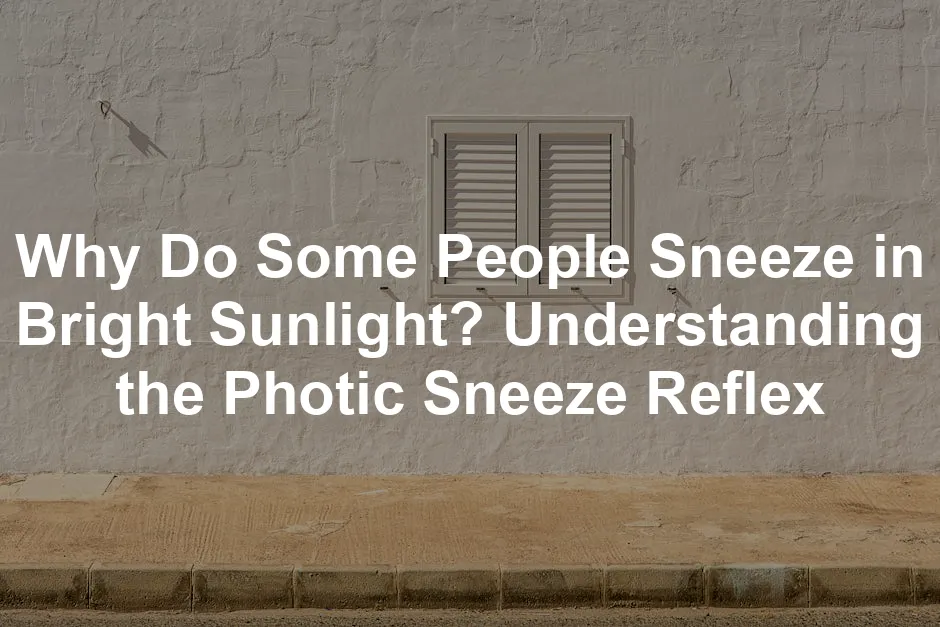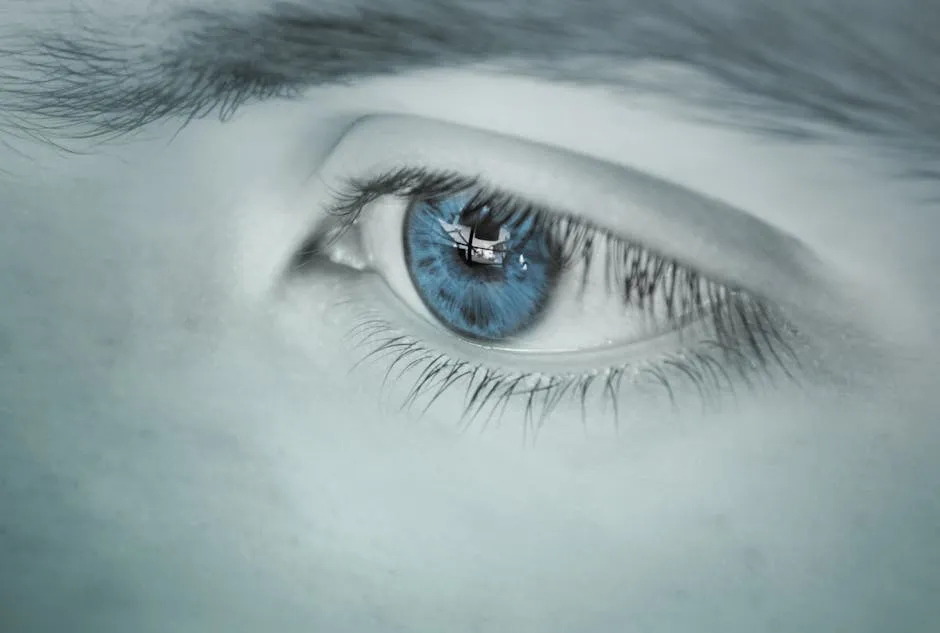
Why Do Some People Sneeze in Bright Sunlight? Understanding the Photic Sneeze Reflex
Introduction
Have you ever stepped outside and sneezed like a startled cat? If so, you might be experiencing the photic sneeze reflex. This quirky phenomenon causes some individuals to sneeze when they transition from darkness to bright light, particularly sunlight. It’s estimated that around 10-35% of the population is affected, making it a surprisingly common occurrence. Interestingly, this reflex appears to be inherited genetically. If a parent sneezes when hit by sunlight, there’s a good chance their offspring will too.
But why does this happen? What’s the science behind this reflex? In this article, we’ll explore the reasons behind the photic sneeze reflex, its implications for daily life, and how to manage it. Whether it’s a benign quirk or a potential hazard, understanding this phenomenon can help you navigate sunny days with a little more grace.

And while you’re navigating those sunny days, why not do it in style? Protect your eyes with a pair of Ray-Ban RB2132 New Wayfarer Sunglasses. Not only will they shield your eyes from the sun, but they’ll also make you look effortlessly cool—like you just stepped off a movie set!
What is the Photic Sneeze Reflex?
The photic sneeze reflex, also known as ACHOO syndrome (Autosomal Dominant Compelling Helioophthalmic Outburst), is a fascinating response to bright light. It typically occurs when someone moves from a dark environment into intense light, like stepping outside on a sunny day.
As the bright light hits the eyes, it sends signals to the brain. For some, this triggers a sneeze. Before sneezing, many people report a peculiar sensation—a tingling or prickling feeling in their nose or face. This sensation often precedes the sneeze, making it feel almost inevitable. The intensity of this reflex can vary significantly from person to person. Some might only experience a single sneeze, while others may unleash a series of them, leaving bystanders amused and a little bewildered.
What’s the connection? Experts believe that the trigeminal nerve, which is responsible for facial sensations, gets crossed signals from the optic nerve when exposed to bright light. This mix-up can trigger the sneeze reflex. Although the exact mechanism remains a mystery, the experience is undeniably real for those who suffer from it.
So, the next time you find yourself sneezing under the sun, just remember: it’s not just you! You might be among the many who share this curious trait.

While you’re sneezing, don’t forget to protect your skin! Try Neutrogena Ultra Sheer Dry-Touch Sunscreen SPF 100. It’s like a force field for your skin against those harmful rays and will keep your face looking fresh and fabulous!
Formal Investigations
In the 1950s, French researcher Jean Sedan made a groundbreaking discovery. He noticed that some patients sneezed when exposed to bright light while he examined their eyes. Sedan’s observations marked the beginning of formal investigations into the photic sneeze reflex. He found that his subjects would sneeze not only when exposed to his ophthalmoscope but also under bright sunlight and even from flash photography. This was a light bulb moment, quite literally!
As time went on, understanding of this phenomenon evolved. The term “photic sneeze reflex” was coined, highlighting the fascinating connection between light exposure and sneezing. By the 1960s, further studies revealed that this reflex affected a notable percentage of the population. In those early investigations, it was estimated that between 17% to 35% of people experienced this quirky reaction. This phenomenon wasn’t just a rare occurrence; it was a genetic trait passed down through families.
The intrigue surrounding the photic sneeze reflex continued to grow. Researchers began to link the reflex to genetic inheritance patterns, with the condition classified as autosomal dominant. This means if one parent has the reflex, there’s a 50% chance that their child will also exhibit this peculiar tendency. As the years rolled on, more studies emerged, painting a clearer picture of the genetic basis behind photic sneezing.
Notably, the early 1990s brought more attention to the genetic links of the reflex. Researchers identified potential genetic markers associated with the condition, paving the way for further exploration. Today, the photic sneeze reflex remains an intriguing subject, blending genetics and neurology in a way that keeps scientists scratching their heads and sneezing in surprise.
In summary, Sedan’s pioneering work in the 1950s laid the foundation for our current understanding of the photic sneeze reflex. The evolution of research has transformed this curious reaction from an obscure observation into a recognized genetic phenomenon, captivating both researchers and the public alike.

Neurological Insights
The photic sneeze reflex is quite a curious phenomenon. At the heart of this reflex lies the trigeminal nerve, a major player in our facial sensation and motor control. When bright light strikes the retina, it sends a signal to the brain via the optic nerve. But here’s where it gets interesting! This signal can inadvertently cross wires with the trigeminal nerve.
Imagine your brain trying to multitask, handling both light and nasal sensations. This crossed stimulation can confuse the trigeminal nerve, interpreting the light signal as an irritant in the nose. Consequently, your body responds with a sneeze—voilà! You’ve just sneezed thanks to sunlight.
This connection isn’t just a coincidence. It’s a fascinating example of how closely linked our sensory pathways are. So, the next time you sneeze in bright sunlight, remember, it’s your brain pulling a fast one on you!

Possible Triggers and Variability
Not all light is created equal! Different types of light can provoke the photic sneeze reflex. For instance, sunlight is a common trigger, but artificial light sources like flash photography can also induce sneezing. This variability is due to the intensity and suddenness of the light exposure.
But wait, there’s more! Individual responses to light vary significantly. Some people may sneeze once, while others might unleash a flurry of sneezes. Situations like stepping outside after being in a dark room or turning on bright lights can heighten the likelihood of sneezing. It’s like a sneeze party, and everyone’s invited—just not equally! Each person’s unique neurobiology plays a significant role in how they react to light.
So, if you find yourself sneezing at the sun while others stand unaffected, take solace in your uniqueness. It’s just your body’s quirky way of reacting to the world around you!

And speaking of reactions, if you’re looking for something to keep you hydrated during those sunny days, check out the Hydro Flask Water Bottle. It keeps your drinks cold for hours, so you can stay refreshed and sneeze-free!
Prevalence and Demographics
The photic sneeze reflex isn’t just a personal quirk; it’s a shared experience for many! Studies indicate that approximately 10-35% of the population exhibits this peculiar reaction to bright light. But it’s not evenly distributed across groups. Research shows notable variations across different demographics.
For instance, a 1964 study by Henry Everett found that 28% of white males and 15% of white females experienced photic sneezing. Interestingly, only about 2% of Black males and females reported the reflex. This suggests that ethnicity plays a role in susceptibility to this phenomenon.
Gender differences also emerge, with research indicating a higher prevalence among females. A study from AncestryDNA noted that about 67% of photic sneezers were women. Genetic factors might explain these trends, as the photic sneeze reflex is inherited in an autosomal dominant manner. If a parent has the reflex, there’s a 50% chance their child will inherit it.
In summary, the photic sneeze reflex is not just a whimsical occurrence; it’s a genetic trait with fascinating demographic variations. Understanding these patterns might help researchers uncover the mysteries behind this curious quirk.

If you’re curious about the science behind sneezing, you might enjoy The Science of Sneezing: A Comprehensive Guide. It dives deep into the mechanics of sneezing and all the fascinating facts you never knew you needed!
Risks and Management of Photic Sneezing
Potential Risks
Sneeze-induced surprises in bright sunlight can pose some serious risks. Imagine driving through a tunnel, only to emerge into blinding daylight. If you sneeze at that moment, the temporary blindness could lead to a fender bender! It’s a bit like playing dodgeball on the highway—only without the fun.
Certain professions also face unique dangers. Pilots, for example, need to keep their eyes on the horizon. A sudden sneeze can interrupt focus, leading to critical errors. Similarly, athletes, especially those in baseball or gymnastics, must maintain concentration during key moments. A sneeze could mean the difference between catching a fly ball or landing a perfect dismount.
For individuals working in high-stakes environments, the photic sneeze reflex can be more than just a funny quirk—it can trigger genuine concern.

Management Strategies
Fortunately, managing photic sneezing isn’t rocket science. A simple pair of sunglasses can work wonders! Wearing shades helps shield your eyes from sudden brightness, significantly reducing the likelihood of a sneeze attack. Think of it as your stylish shield against unwanted surprises!
Avoiding abrupt transitions from darkness to light is another smart strategy. So, next time you’re leaving a dimly lit building, give yourself a moment to adjust to the brightness before stepping out.
Another nifty technique involves applying pressure to the philtrum—the groove right under your nose. Just gently press with your finger and hold for a moment. This action might help override the irritation that triggers the sneeze reflex. It’s like telling your nose, “Chill out, I got this!”
Lastly, staying aware of your surroundings can make a difference. If you know bright sunlight awaits, take precautions ahead of time. With these tips in mind, you can enjoy sunny days without the surprise sneezes!

And if you’re looking for a convenient way to keep track of your health while managing those sunny days, consider the Fitbit Charge 5 Fitness Tracker. It monitors your activity levels and helps you stay fit while you explore the world!
Cultural Perspectives on Sneezing
Sneezing isn’t just a biological response; it carries cultural weight, too! Various societies have woven beliefs around this reflex. In some cultures, a sneeze is seen as a sign of good fortune or a message from the universe. For instance, in ancient Rome, a sneeze was thought to signal that a god was nearby, perhaps as a friendly reminder to stay alert.
Conversely, in certain Eastern traditions, sneezing can indicate that someone is talking about you. One sneeze suggests positive chatter, while two sneezes might mean the gossip isn’t so nice. Talk about pressure—the next time you sneeze, you might wonder who’s chatting about you!
Historically, during the plague, sneezing took a darker turn. It became associated with illness and impending doom. People began to fear a sneeze could signal something sinister, leading to social distancing long before it was a common practice.
In modern times, while sneezing is often met with polite “bless yous,” its cultural significance remains strong. It’s fascinating how a simple reflex can evoke such varied interpretations across different times and places. Whether a sign of luck or a cautionary tale, sneezing truly keeps us on our toes!

If you’re intrigued by how the mind and body work together, you should check out The Body Keeps the Score. It provides incredible insights into how our experiences shape our health.
FAQs
What percentage of people sneeze in bright sunlight?
Research indicates that around 10-35% of people experience the photic sneeze reflex. A study from 1995 found that approximately 33% of patients at an eye clinic exhibited this reaction. More recent research showed that about 25% of individuals in a 2019 study in China also reported similar experiences. These statistics highlight how common this reflex can be, making it a shared phenomenon rather than an isolated quirk.
Is photic sneezing harmful?
Generally, photic sneezing is benign. However, it can pose risks in specific situations, like driving or performing athletics. A sudden sneeze can momentarily impair vision, which can be dangerous when navigating busy roads or participating in high-stakes activities. Awareness of the reflex and taking precautions can help minimize these risks.
Can photic sneezing be treated?
There’s no medical treatment for photic sneezing, but management strategies can help. Wearing sunglasses when going outdoors can shield your eyes from bright light, reducing the likelihood of sneezing. Additionally, applying pressure to the philtrum (the groove under your nose) may help override the sneeze reflex. These simple adjustments can make a significant difference in daily life.
Why do some people not sneeze in sunlight?
Genetic variability is the main reason some individuals don’t sneeze in bright light. Not everyone inherits the genetic markers associated with the photic sneeze reflex. While many experience this quirky reaction, some might completely lack the reflex due to their unique genetic makeup. This variability adds to the intrigue of the phenomenon, showcasing the diverse ways our bodies respond to the world around us.
Please let us know what you think about our content by leaving a comment down below!
Thank you for reading till here 🙂
And don’t forget, if you ever need a quick caffeine boost, grab a Portable Espresso Maker. It’s perfect for those moments when you need a pick-me-up on the go!
All images from Pexels




